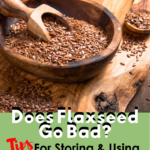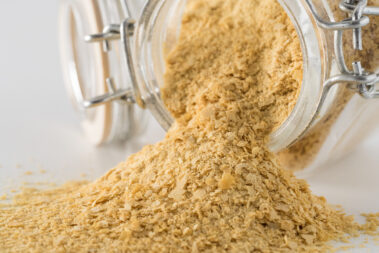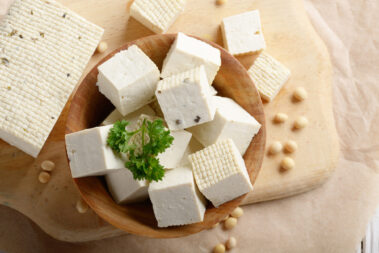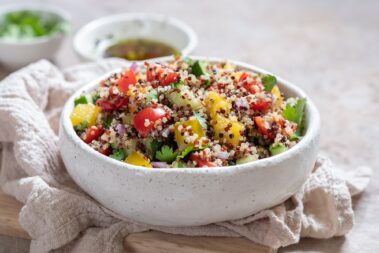You already know what a powerhouse of nutrients and omega-fatty acids flaxseed is. But I bet you didn’t know that those fragile healthy fats also go bad very quickly.
In fact, most flaxseed you buy will start to turn well before the expiration date.
Below, we’ll give you the scoop on how and when flaxseed goes bad, how to tell if yours has turned, and offer our expert tips for extending its shelf life.
Table of Contents
Do Flaxseeds Go Bad?
When it comes to superfoods that actually live up to the hype, there’s no better, more versatile example than flaxseed.
Not only are these little seeds packed with heart-healthy omega-3s, but they are also an antioxidant powerhouse containing 800 times more lignans than your typical fruit or veggie. Lignans are important for fighting inflammation and reducing your risk for certain cancers. And on top of everything else, flaxseeds are loaded with minerals, fiber, and protein.
Unfortunately, all those fragile fats mean that flaxseeds have a relatively short shelf life. In fact, any food that contains a lot of good-for-your-heart fats is at an increased risk for spoilage compared to your typical dry grain, seed, or oil. That’s because the same structure that makes omegas so useful to cells in the body also sets these molecules up to degrade quickly.
When exposed to oxygen and light, the highly reactive double bonds that create the molecule’s structure begin to oxidize and produce byproducts like aldehydes and lipid peroxides. Not only does this process reduce the health benefits of your flaxseed, but some of these byproducts can actually be harmful to your health while reducing the nutrient profile of the seed itself.
Still, it’s unlikely you’d become sick, except for possibly some minor stomach upset, from eating rancid flaxseeds. But, because flaxseeds that have gone bad are less nutritious and don’t taste as good, it’s best to avoid them.
How Do You Know If Your Flaxseeds Have Gone Bad?
If you think your flaxseed might be bad, try giving it a sniff or tasting a small dab. Unspoiled flaxseed typically has a nice nutty flavor and smell, while rotten seeds will smell fishy and have a bitter taste.
Another thing to be mindful of with flaxseed is mold.
If your flaxseed is exposed to moisture and contaminants, it will likely start to mold. This can be very dangerous. So if you notice fuzzy white or green splotches on your flaxseed, throw the whole thing out right away.
How Long Does Flaxseed Last?
The printed-on expiration date for most whole flaxseed you’ll find at the store is between one and two years from the date of packaging. For meals, it tends to be less than a year. With proper storage, it’s possible to extend the life of your flaxseed well past these dates.
However, it’s also important to remember that how the flax was stored before you bought it plays a part in whether it’ll last until that stated expiration. Since most flaxseed packages aren’t completely airtight and many are translucent, it’s even possible to buy flaxseed that has already started to turn, even if the expiration date is a ways off.
To reduce the odds of this, it’s best to purchase your flaxseed from grocers that store it and other high-omega seeds in the refrigerator section rather than on the shelf. And, whether refrigerated or not, always opt for brands that package their seeds in an opaque bag rather than a clear one.
Expert Tip: How to Store Flaxseed to Prolong Its Shelf Life
Once you have your precious flaxseeds home, you’ll want to take some additional steps to prolong their shelf life and avoid spoilage, especially once you’ve opened the package.
(And if you’re suddenly worried that you may be storing all your food in the wrong place, here’s a nifty food storage chart that can help you out.)
In the Pantry
It’s perfectly ok to store whole flaxseed in the pantry if the package has not been opened. This is only true if the product was stored on the shelf at the store. While it’s likely to undergo some spoilage sitting in a room-temperature cupboard, an unopened, opaque package will be protected enough from light and oxygen that it should last at least up to the expiration date.
The one time you definitely don’t want to store your flaxseed in the pantry is if it was previously kept in the refrigerator.
Omega fatty acids are more stable at lower temperatures no matter what. But shifts between cooler and warmer temps can actually speed the degradation process beyond what you would see if seeds were always kept at a stable, higher temp. So if your seeds were cold when you bought them, definitely keep them that way.
In the Fridge
The fridge is the optimal place to store your flaxseed even when the package is unopened. And after the package has been opened, the fridge is the only place you should store it. The cooler temps and protection from light will help ward off spoilage. In fact, whole flaxseed left in the fridge will likely stay good for up to a year past the printed-on expiration date.
Flaxseed meal can also be stored in the fridge if you plan to use it up within a week.
In the Freezer
Whole flaxseed stored in the freezer will last a touch longer than flaxseed in the fridge. But, make sure you transfer the amount you need straight to your breakfast smoothie, homemade instant oatmeal, or other recipe quickly. This is because prolonged thawing will cause the omegas to break down rapidly.
Also, never move frozen flaxseed stores out of the freezer and into the fridge or pantry.
Because flaxseed meal has been processed into smaller pieces, it’s at a far greater risk of spoiling than whole seeds. These pulverized pieces have more surface area exposed to light and oxygen and no longer have the benefit of being protected by an intact shell.
For this reason, flaxseed meal should always be stored in the freezer unless you plan to use it quickly (in which case, the fridge is fine). Just as with whole seeds, avoid allowing flaxseed meal to thaw before putting it to use, and never transfer your stores between the freezer and fridge or cupboard.
Since flaxseed meal breaks down so quickly under the wrong conditions, it’s advisable to only purchase whole seeds and grind them yourself at home. Ground seeds stored in the freezer should last about two months past the original whole-seed expiration date.
Our Favorite Flaxseed Recipes
One easy way to make sure your flaxseed doesn’t go bad is to use it up by substituting easy flaxseed eggs for real eggs in your baking or by making some of these tasty recipes.
- Easy Flaxseed Crackers – Flaxseeds are the star in these super simple but incredibly delicious and versatile homemade crackers.
- Vegan Flaxseed Pancakes – Hearty, healthy, and so good, these pancakes are the perfect way to start your day.
- Vegan Protein Cookies – Substitute flaxseeds in this yummy recipe for the hemp seeds for an equally healthy cookie with a boost of omega fatty acids.
- Rustic Rosemary Herb Crackers – The perfect delicate rosemary flavor and satisfying crunch for an easy and delicious snack.
- Gluten-Free Waffles – Pair these hearty waffles with dairy-free homemade whipped cream for the ultimate breakfast treat.
There you have it! Everything you need to know about why flaxseed goes bad, how you can improve its shelf life, and some of our favorite flaxseed recipes.
Get more helpful kitchen tips sent straight to your inbox by signing up for our newsletter. Simply scroll to the bottom of the page and add your email to the newsletter sign-up box.
If you found this article helpful or have any other questions about flaxseed use and storage, leave a comment in the section below.
Feature photo: ©gorchittza2012/Bigstock
- How to Pick the Perfect Watermelon For a Sweet Summer Treat - April 10, 2024
- Future Kind’s Foundations: A Multivitamin Made for Vegans - December 5, 2023
- Does Nutritional Yeast Go Bad? - November 28, 2023








